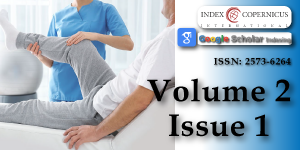Biomechanical analysis of Sit-To-Walk movement in Parkinson’s patients
Main Article Content
Abstract
Aim: The aim of this study was to evaluate the ankle-knee-hip interaction during sit-to-walk (STW) movement and clinical functional abilities of the lower limbs in Parkinson’s patients.
Methods: Twenty male patients, ages ranged from 55 to 70 years, stage ΙΙ & ΙΙΙ according to modified Hoehn and Yahr (1997) classification of disabilities and ten male healthy elderly subjects, ages ranged from 55 to 70 years, participated in this study. All subjects were assessed for; clinical functional abilities of the lower limbs, ground reaction force (GRF) & spatiotemporal data and range of motion (ROM) of hip, knee and ankle joints during STW movement.
Results: The results showed very significant differences in the GRF among the normal subjects and Parkinson’s patients during STW movement. There were significant differences in hip, knee and ankle joints ROM during STW. There were significant differences in spatiotemporal findings during STW movement. The Parkinson’s disease patients did not merge the two tasks of STW while the elderly subjects merged it. There was impairment in clinical functional abilities of the lower limbs in Parkinson’s patients.
Conclusion: A continuum of STW performance and clinical functional abilities whereby the healthy elderly people performed the task more efficiently than PD patients.
Article Details
Copyright (c) 2018 El Semary MM, et al.

This work is licensed under a Creative Commons Attribution 4.0 International License.
Ueno E, Yanagisawa N, Takami M. Gait disorders in Parkinsonism. A study with floor reaction forces and EMG. Adv Neurol. 2005; 60: 414-418.
Gelb DJ, Oliver E, Gilman S. Diagnostic criteria for Parkinson's disease. Arch Neurol. 1999; 56: 33-39. Ref.: https://goo.gl/LPeiaV
Kerr A, Durward B, Kerr KM. Defining phases for the sit-to-walk movement. Clin Biomech. 2004; 19: 385-390. Ref.: https://goo.gl/3N3XXA
Hass CJ, Gregor RJ, Waddell DE, Oliver A, Smith DW, et al. The influence of Tai Chi Training on the Center of Pressure Trajectory During Gait Initiation in Older Adults. Arch Phys Med Rehabil. 2004; 85: 1593-1598. Ref.: https://goo.gl/BHCKqi
Kerr A, Rafferty D, Kerr KM, Durward B. Timing phases of the sit-to-walk movement: Validity of a clinical test. Gait Posture. 2006.
Shinkai S, Watanabe S, Kumagai S, Fujiwara Y, Amano H, et al. Walking speed as a good predictor for the onset of functional dependence in a Japanese rural community population. Age Ageing. 2000; 29: 441-446. Ref.: https://goo.gl/UMBhKY
Bluman AG. Elementary statistics: A step by step approaches, 5th ed. McGraw-Hill Higher Education. Boston, New York, London. 2004; 431-583. Ref.: https://goo.gl/TSELeN
Lusardi MM, Pellecchia GL, Schulman M. Functional performance in community living older adults. J Geriat Phys Ther. 2003; 26: 14-22. Ref.: https://goo.gl/Xgfnsk
Baer G, Smith M. The recovery of walking ability and subclassification of stroke. Physiother Res Int. 2001; 6: 135-144. Ref.: https://goo.gl/a2j7k3
Kerr A, Rafferty D, Kerr KM, Durward B. Timing phases of the sit-towalk movement: Validity of a clinical test. Gait & Posture. 2007; 26: 11-16. Ref.: https://goo.gl/dCXAaW
Mak MKY, Levin O, Mizrahi J, Hui-Chan CW. Joint torques during sit-to-stand in healthy subjects and people with Parkinson's disease. Clin Biomech. 2003; 18: 197-206. Ref.: https://goo.gl/8smW3m
Ramsey VK, Miszko TA, Horvat M. Muscle activation and force production in Parkinson's patients during sitto-stand transfers. Clin Biomech. 2004; 19: 377-384. Ref.: https://goo.gl/cPJEiU
Butler PB, Nene AV, Major RE. Biomechanics of transfer from sitting to the standing positioning some neuromuscular diseases. Physiother. 1991; 77: 81 - 88.
Crocus DM, Chen CM, Quinn NP, McAuley J, Rothwell JC. Strength in Parkinson's disease: relationship to rate of force generation and clinical status. Ann Neurol. 1996; 39: 79-88. Ref.: https://goo.gl/fFN7x4
Magnan A, McFadyen BJ, St-Vincent G. Modification of the sit-to-stand task with the addition of gait initiation. Gait and Posture. 1996; 4: 232-241. Ref.: https://goo.gl/Mbwyng
Kerr A, Durward B, Kerr KM. Defining phases for the sit-to-walk movement. Clin Biomech. 2004; 19: 385-390. Ref.: https://goo.gl/26nLmK
Malouin F, McFadyen B, Dion L, Richards CL. A fluidity scale for evaluating the motor strategy of the rise to walk task after stroke. Clin Rehabil. 2003; 17: 674-684. Ref.: https://goo.gl/xFjxYw
Bloem BR, Beckley DJ, Van Dijk JC, Zwinderman AH, Remler MP, et al. Influence of dopaminergic medication on automatic postural responses and balance impairment in Parkinson's disease. Mov Disord. 2003; 11: 509-521.
Buckley TA. Dynamic postural stability during the sit-to-walk transition in individuals with Parkinson's disease. Doctoral dissertation. Columbia University. 2007; 50-90.





